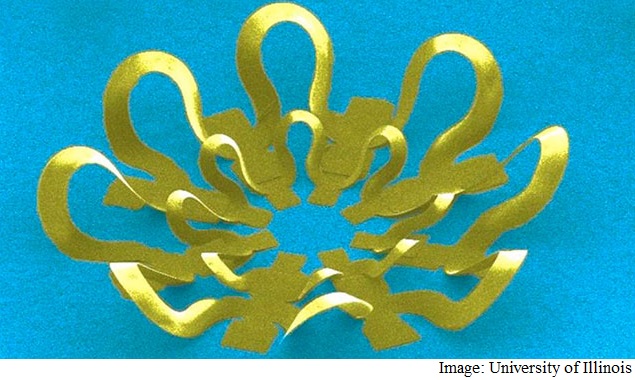- Home
- Science
- Science News
- Researchers Develop 'Pop Up' 3D Fabrication Technique
Researchers Develop 'Pop-Up' 3D Fabrication Technique

Using a variety of advanced materials, including silicon, the researchers said they produced more than 40 different geometric designs, including shapes resembling a peacock, flower, starburst, table, basket, tent and starfish.
"In just one shot you get your structure," Xinhua news agency quoted co-corresponding author Huang Yonggang, professor of the Northwestern University, as saying in a statement Thursday.
"We first fabricate a two-dimensional structure on a stretched elastic material. Then we release the tension, and up pops a 3D structure. The 2D structure must have some place to go, so it pops up."
The pop-up assembly technique trumps 3D printing on many levels, Huang said.
The method is fast, inexpensive and can utilise many different materials, including silicon, to produce a wide range of structures down to a thickness of 100 nanometres, he said.
Moreover, it can be used to build many different structures at one time and incorporate different materials into one hybrid structure.
3D printing, on the other hand, manufactured objects layer by layer slowly. It is difficult for 3D printing to integrate more than one material in a structure, and it is almost impossible to print semiconductors or single crystalline metals.
The researchers said their pop-up technique has great potential for use in a wide variety of man-made systems, including biomedical devices, sensors and electronics.
"A key, unique feature of these approaches to 3D micro-architectures is that they work equally well with a very wide variety of materials, including the highest performance semiconductors, such as device-grade silicon," said co-corresponding author John Rogers, professor of the University of Illinois.
"We believe, as a result, that these ideas have relevance to nearly every class of microsystem technology - from electronics to photonics, optoelectronics, microelectromechanical structures and others."
The study, published in the US journal Science, also included researchers from China's Zhejiang University, East China University of Science and Technology and Tsinghua University as well as researchers from South Korea's Hanyang University.Catch the latest from the Consumer Electronics Show on Gadgets 360, at our CES 2026 hub.
Related Stories
- Samsung Galaxy Unpacked 2025
- ChatGPT
- Redmi Note 14 Pro+
- iPhone 16
- Apple Vision Pro
- Oneplus 12
- OnePlus Nord CE 3 Lite 5G
- iPhone 13
- Xiaomi 14 Pro
- Oppo Find N3
- Tecno Spark Go (2023)
- Realme V30
- Best Phones Under 25000
- Samsung Galaxy S24 Series
- Cryptocurrency
- iQoo 12
- Samsung Galaxy S24 Ultra
- Giottus
- Samsung Galaxy Z Flip 5
- Apple 'Scary Fast'
- Housefull 5
- GoPro Hero 12 Black Review
- Invincible Season 2
- JioGlass
- HD Ready TV
- Laptop Under 50000
- Smartwatch Under 10000
- Latest Mobile Phones
- Compare Phones
- OPPO Reno 15 Pro Max
- Honor Win RT
- Honor Win
- Xiaomi 17 Ultra Leica Edition
- Xiaomi 17 Ultra
- Huawei Nova 15
- Huawei Nova 15 Pro
- Huawei Nova 15 Ultra
- Asus ProArt P16
- MacBook Pro 14-inch (M5, 2025)
- OPPO Pad Air 5
- Huawei MatePad 11.5 (2026)
- Xiaomi Watch 5
- Huawei Watch 10th Anniversary Edition
- Acerpure Nitro Z Series 100-inch QLED TV
- Samsung 43 Inch LED Ultra HD (4K) Smart TV (UA43UE81AFULXL)
- Asus ROG Ally
- Nintendo Switch Lite
- Haier 1.6 Ton 5 Star Inverter Split AC (HSU19G-MZAID5BN-INV)
- Haier 1.6 Ton 5 Star Inverter Split AC (HSU19G-MZAIM5BN-INV)

















